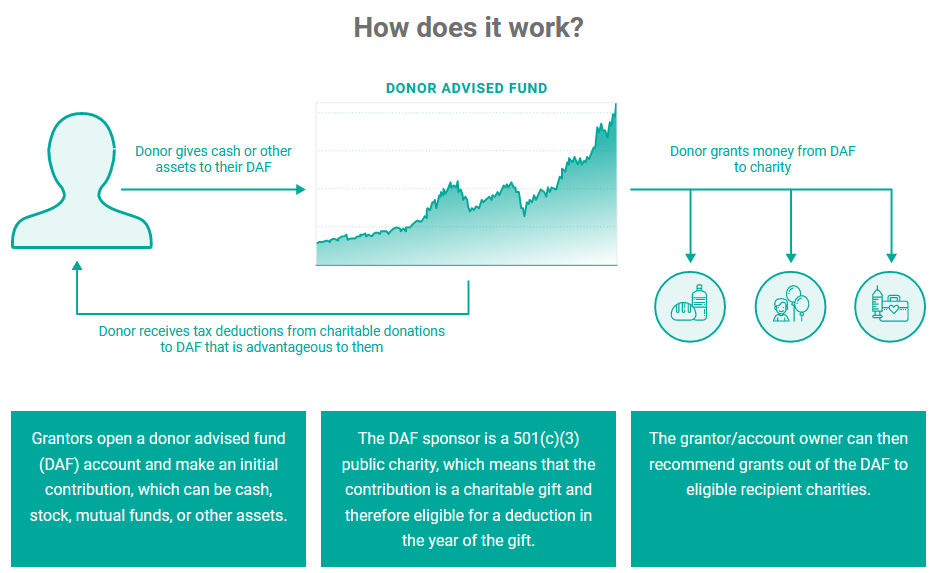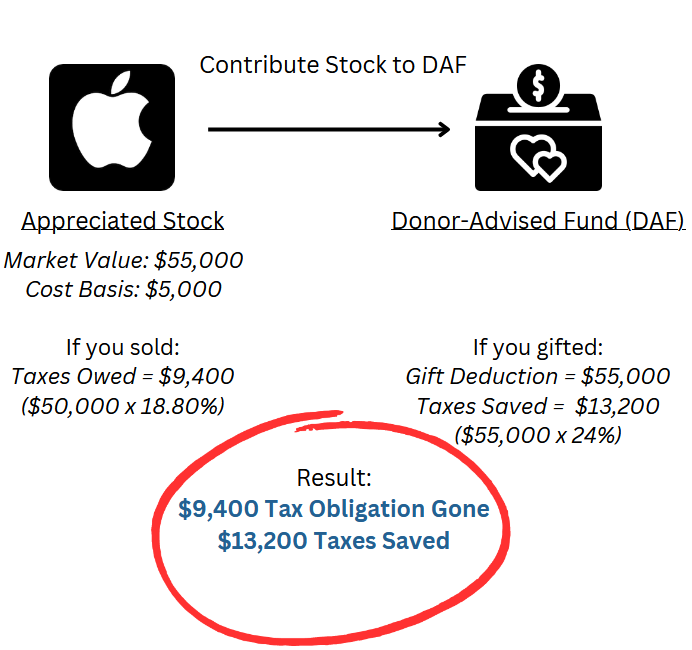
Avoid This Common Charitable Giving Mistake to Max Your Tax Savings (and Impact)
KEY TAKEAWAYS:
- Many people unknowingly miss out on a big benefit of charitable giving – tax savings – by not having a giving strategy.
- Developing a multi-year giving strategy using a donor-advised fund can unlock sizeable tax savings and help boost impact.
- For people ages 70.5+, Qualified Charitable Distributions (QCDs) offer even greater tax savings.
Individuals account for the majority of U.S. charitable giving. This isn’t surprising given the many benefits of charity, like improving society, bettering our health, expressing our values, and, of course, tax savings.
Although financial benefit isn’t the primary motivator behind charitable giving, developing a multi-year giving strategy can maximize the win-win scenario by boosting not only your tax savings but also your impact. But despite the tremendous benefits of having a strategy, many people approach their giving on a year-to-year basis, often resulting in no tax benefit at all (much to their surprise)!
As retirement planning specialists, we guide clients to make the most of their charitable giving while improving their retirement income planning through some of the strategies we’re about to share with you here.. But first, it helps to understand how the tax system works as it relates to charitable giving because it’s often a little more complex than people think…
Tax Law and The Need for Strategic Giving
The ability to receive a tax deduction for charitable gifts has become much more challenging due to the 2017 Tax Cuts and Jobs Act, which nearly doubled the standard deduction for taxpayers. In fact, approximately 90% of taxpayers now take the standard deduction (versus ~70% before the TCJA)!
This matters because charitable gifts are an itemized deduction, meaning your gift and other itemized deductions (like mortgage interest) must be greater than your standard deduction to receive tax savings. Since the Tax Cuts and Jobs Act is set to expire at the end of 2025, this could change the situation for charitable giving in the future. However, let’s continue with illustrating the current state of things with the standard deduction being much higher than what most people end up accumulating in itemized deductions.
When Itemized Deductions Aren’t Enough to Make Your Gift Count
Here’s an example of something we see all too often. In this case, a married couple gives $5,000 to charity in 2025. However, as you see, they don’t receive a tax benefit from their gift because their itemized deductions are less than their standard deduction ($30,000 for a couple under age 65).
Itemized Deduction or Standard Deduction?
Standard Deduction of $30,000 is greater than itemized deductions of $22,500.
In this example, we see that because the couple’s itemized deductions are less than their standard deduction, they don’t get any benefit from the gifts they made that year.
So what can they do to change that? Enter the Donor-Advised Fund.
“Batch” Your Gifts with a Donor-Advised Fund
Just like how 401(k)’s are tax-advantaged accounts for retirement, donor-advised funds are tax-advantaged accounts for charity. And, when used smartly by “batching” multiple years of gifts into one year, they allow you to maximize your tax savings.
Donor-advised fund tax benefits include immediate charitable deductions, tax-free growth of assets, and the ability to avoid capital gains taxes on appreciated donations. So let’s take a look at an example of how a donor-advised fund works.
Let’s assume that our married couple decides to batch five years of their gifts into one year by making a $25,000 contribution (5 x $5,000 annual gift) to a donor-advised fund in 2025. By employing this giving strategy, they can report the full $25,000 gift on their 2025 tax return, allowing them to take advantage of itemizing their deductions. This reduces their income by $12,500 more than if they settled for the standard deduction ($42,500-30,000 = $12,500)!
Itemized Deductions of $42,500 are greater than the standard deduction of $30,000.
For the 2026 tax year, they would switch back to taking the standard deduction until they are ready to “batch” additional contributions to their donor-advised fund. Lather, rinse, repeat.
We recognize that (most) people don’t want to give multiple years of gifts to charities all at once, and with a donor-advised fund, you don’t have to. Although our hypothetical couple contributed five years of gifts to their donor-advised fund in 2025, they have the option to give the entire $25,000 to charities immediately (in 2025) or spread the gifts across five years (or whatever gifting schedule they want).
Remember that a donor-advised fund is a tax-advantaged account, and, like a 401(k), you can invest your contributions to grow the account balance (tax-free) and make disbursements when you choose. When considering investment growth, our couple’s $25,000 contribution can potentially fund more giving over five years than they had planned. This can help them make an even greater impact or reduce the dollar amount necessary for their initial contribution.
Boost Your Tax Benefits With a Donor-Advised Fund
Contributions to donor-advised funds can be either cash or assets. Many of our clients wonder why and how to donate appreciated stock to charity. And we can’t emphasize the benefit of donating stock to charity enough. Contributing assets – specifically appreciated assets, like stock – are much more advantageous than cash.
This is due to two reasons: (1) you receive a tax deduction based on the market value of the stock at the time of the contribution to your DAF, and (2) you get rid of the future capital gains tax obligation that’s embedded in the stock’s value.
In the example above, Apple stock bought ten years ago for $5,000 is contributed to a donor-advised fund. The Donor reports the stock's current market value ($55,000!) as a charitable gift (an itemized deduction) on their tax return. If they’re in the 24% federal tax bracket, this represents a $13,200 tax savings (even bigger if we factored in state taxes)! If that isn’t compelling enough, they also eliminate the $9,400 future tax liability that would have been triggered when they sold the Apple stock (15% long-term capital gains rate + 3.8% net investment income tax).
Don’t Forget Qualified Charitable Distributions (QCDs)
If you’re age 70.5 or older and have an IRA, a potentially more powerful giving option is available. Qualified Charitable Distributions (QCDs) are gifts made directly from IRAs to qualified charities. You don’t need to itemize deductions to receive a tax benefit from a QCD (unlike DAF contributions). And, because they are an “above-the-line deduction,” you receive the full deduction for your charitable gift (up to the $100,000 annual limit), which isn’t always the case for itemized charitable deductions.
While we are big fans of donating appreciated assets, QCDs go towards satisfying required minimum distributions and offset income taxed at higher tax rates (ordinary income from IRAs) versus preferential long-term capital gains rates. This means that, depending on your situation, QCDs may be more advantageous than a donor-advised fund.
Optimize Your Charitable Giving Strategy with DAFs and QCDs
The takeaway is that a meaningful tax savings opportunity exists in taking a strategic approach to charitable giving. Many rules add constraints to using donor-advised funds and qualified charitable distributions, so your giving strategy must be tailored to your unique circumstances and preferences.
If you need help developing a giving strategy to maximize your tax savings and impact, we are here to help. Schedule a call with one of our retirement planning specialists to get a complimentary Thrive Assessment and see how your gifting strategy can help you reduce taxes and optimize your retirement planning.



